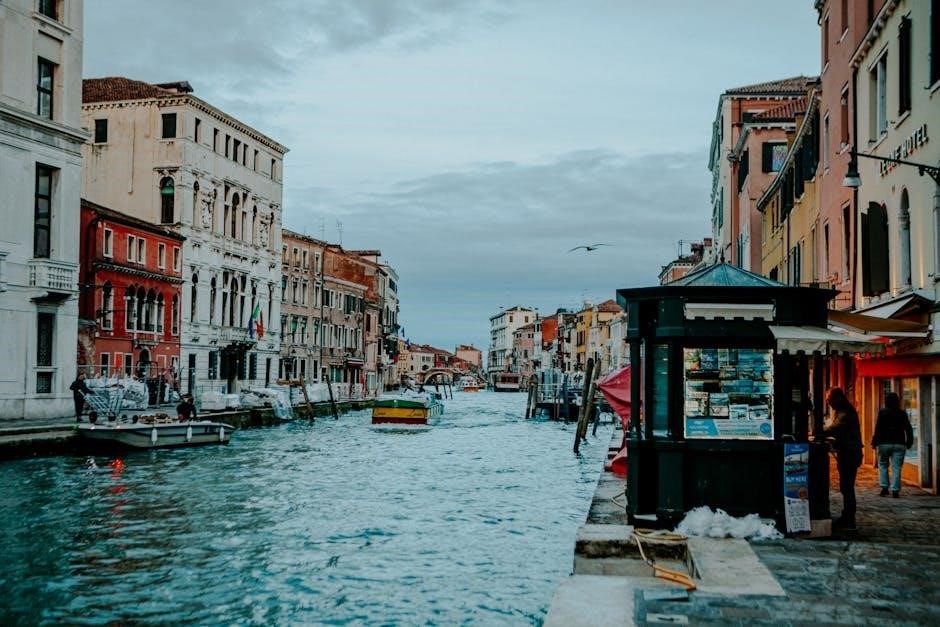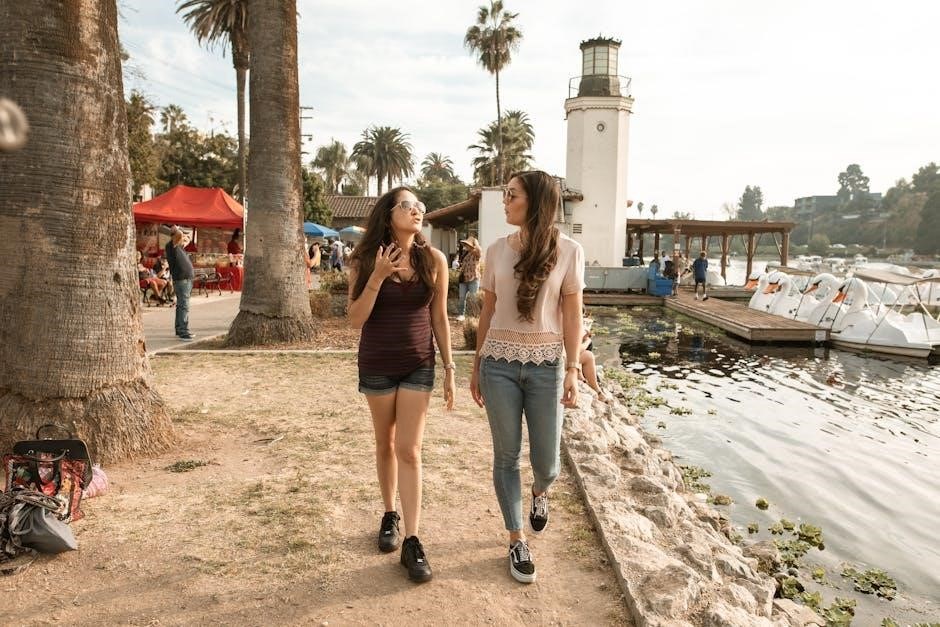
Overview of the Regents Canal Walk
Discover the charm of London’s hidden waterway with the Regents Canal Walk, a scenic route from Little Venice to Limehouse Basin. Download the PDF map to explore vibrant houseboats, quaint pubs, and urban art, offering a unique perspective on the city’s history and culture. Perfect for a leisurely stroll or bike ride, the 8.6-mile path is a must-do for visitors and locals alike.
1.1 What is the Regents Canal Walk?
The Regents Canal Walk is a scenic 8.6-mile route in London, stretching from Little Venice to Limehouse Basin. This charming waterway offers a peaceful escape from the city’s hustle, with a towpath perfect for walking or cycling. The route passes through iconic areas like Camden, King’s Cross, and Haggerston, showcasing vibrant houseboats, quirky pubs, and urban art. It’s a hidden gem that highlights London’s diverse culture and history, making it a must-do for both locals and visitors. The walk provides a unique perspective on the city’s industrial past and modern transformations, with landmarks like Camden Lock and Regent’s Park adding to its allure. A downloadable PDF map is available to guide explorers along this picturesque journey.
1.2 Importance of the Regents Canal Walk Map PDF
The Regents Canal Walk Map PDF is an essential tool for navigating the 8.6-mile route from Little Venice to Limehouse Basin. Downloading the PDF ensures you have a detailed guide, highlighting key landmarks, pubs, and attractions. It helps visitors plan their route, identify shortcuts, and discover hidden gems like Camden Lock and Regent’s Park. The map is particularly useful for self-guided tours, offering a clear layout of the towpath and surrounding areas. With features like zoom functionality and offline access, it’s perfect for explorers of all kinds. Whether strolling leisurely or cycling, the PDF map enhances the experience, making it an indispensable companion for anyone exploring this iconic London waterway.
History of the Regents Canal
Built in 1812-1820, the Regents Canal connected Paddington to Limehouse, named after Prince Regent. It facilitated goods transport, linking Grand Union Canal to the Thames, aiding London’s industrial growth.
2.1 Construction and Opening of the Canal
The Regents Canal was constructed between 1812 and 1820, with the first section opening on October 14, 1816, connecting Paddington to Camden Town. The final section, linking Camden to Limehouse Basin, opened on August 1, 1820. Designed by architect John Nash, the canal was part of a broader plan to develop North London, enhancing trade by connecting the Grand Union Canal to the River Thames. Its construction involved digging an 8.6-mile waterway, which played a crucial role in the transportation of goods like coal and timber during the Industrial Revolution. The canal’s completion marked a significant milestone in London’s infrastructure development.
2.2 Historical Significance of the Canal
The Regents Canal holds profound historical significance as a vital trade route in 19th-century London, connecting the Grand Union Canal to the River Thames. It facilitated the transportation of goods like coal and timber, aiding the city’s industrial growth. Named after King George IV, the canal symbolizes the Regency era’s influence on urban development. Architect John Nash’s involvement in its planning underscores its role in reshaping North London. Over time, the canal transitioned from a commercial hub to a cherished recreational space, reflecting London’s evolving landscape. Today, it remains a testament to the city’s industrial heritage and a popular destination for those exploring its rich history.

Key Landmarks Along the Regents Canal
The Regents Canal passes through iconic spots like Little Venice, Camden Market, and Kings Cross, offering vibrant street art, charming cafes, and cultural landmarks along its scenic route.
3.1 Start and End Points of the Canal
The Regents Canal begins at Little Venice in Paddington, a picturesque junction of the Grand Union and Regents Canals, and ends at Limehouse Basin by the River Thames. This 8.6-mile (13.8 km) waterway connects West and East London, offering a tranquil pathway through the city. The PDF map highlights these endpoints, allowing walkers to plan their route effectively. Little Venice is renowned for its colorful houseboats and serene atmosphere, while Limehouse Basin, once a bustling industrial hub, now offers a glimpse into London’s maritime history. Both points are easily accessible by public transport, making them ideal starting or ending points for your canal walk.
3.2 Notable Attractions Along the Route
As you stroll along the Regents Canal, the PDF map guides you through a diverse array of attractions. Camden Lock stands out, famed for its vibrant market, street food, and eclectic shops. Nearby, the London Zoo offers a unique opportunity to spot wildlife while enjoying the canal’s tranquility. In King’s Cross, the historic Granary Square and its iconic fountains captivate visitors, while the quirky floating bookshop adds charm to the area. Further east, Haggerston’s trendy cafes and Victorian-era factories provide a blend of old and new. The map ensures you don’t miss these highlights, making your walk an enriching exploration of London’s culture, history, and natural beauty.

Regents Canal Walk Map PDF
The Regents Canal Walk Map PDF is a free, downloadable guide highlighting key landmarks, walking routes, and practical details, ensuring a seamless exploration of London’s scenic waterway.
4.1 How to Download the Map
To download the Regents Canal Walk Map PDF, visit trusted sources like official London tourism websites or platforms offering free walking guides. Search for “Regents Canal Walk Map PDF” and select a reliable link. Ensure the map is up-to-date for accurate route details. Once downloaded, save it to your device for easy access during your walk. The map typically includes marked paths, landmarks, and points of interest, making navigation effortless. Offline access is ideal for areas with limited internet coverage along the canal. Print a copy if preferred for a traditional navigation experience. This guide ensures you’re well-prepared to explore London’s scenic waterway seamlessly.
4.2 Features and Benefits of the PDF Map
The Regents Canal Walk Map PDF is a comprehensive guide designed to enhance your walking experience. It includes a detailed route from Little Venice to Limehouse Basin, highlighting key landmarks, start and end points, and notable attractions along the way. The map is easy to navigate, with clear markings for towpaths, parks, and cultural spots. One of its main benefits is offline accessibility, ensuring you can use it even without internet coverage. Additionally, the PDF format allows you to zoom in for detailed views or print it for a traditional navigation experience. This map is perfect for first-time visitors and locals alike, offering a seamless way to explore London’s vibrant waterway and its surroundings.
Exploring Beyond the Canal
Beyond the Regents Canal, discover nearby parks like Regent’s Park and vibrant cultural spots such as Camden Market. Use the PDF map to find these hidden gems easily.

5.1 Nearby Parks and Green Spaces
The Regents Canal Walk is surrounded by stunning parks and green spaces, perfect for extending your adventure. Regent’s Park, home to London Zoo, offers serene landscapes and vibrant gardens. Hyde Park and Kensington Gardens are nearby, providing ample space for picnics and relaxation. These parks are easily accessible from the canal towpath, as indicated on the Regents Canal Walk map PDF. Explore the Queen Mary’s Rose Gardens or visit the Primrose Hill viewpoint for panoramic city vistas. The map PDF helps navigate between the canal and these green oases, ensuring you don’t miss any of London’s natural beauty. These parks add a refreshing contrast to the urban charm of the canal.
5.2 Cultural and Entertainment Options
The Regents Canal Walk offers a vibrant blend of cultural and entertainment experiences. Camden Market is a must-visit, famous for its eclectic shops, street food, and live music. Nearby, Granary Square in King’s Cross boasts trendy cafes, cultural venues, and public art. The Regent’s Park Open Air Theatre hosts outdoor performances during summer, adding a touch of drama to your stroll. Along the canal, you’ll find unique spots like a boat bookshop in King’s Cross, offering a quirky literary experience. Use the Regents Canal Walk map PDF to discover these hidden gems and plan your day exploring London’s diverse cultural landscape. These attractions make the walk a perfect blend of nature, history, and modern city life.

Practical Tips for the Walk
Plan your route with the Regents Canal Walk map PDF, wear comfortable shoes, and bring water and snacks. Check the weather, and enjoy the scenic views and cultural highlights along the way.
6.1 Best Times to Walk the Canal
The best times to walk the Regents Canal are during spring and summer when the weather is mild and sunny, offering vibrant scenery and lively atmosphere. Early mornings provide a peaceful experience, while afternoons allow you to enjoy bustling markets and cafes. Autumn brings colorful foliage, while winter offers a serene, quiet environment. Refer to the Regents Canal Walk map PDF for seasonal highlights and plan your route accordingly to make the most of your stroll along this iconic waterway.
6.2 Essentials to Bring Along
Ensure a enjoyable and comfortable journey along the Regents Canal by packing the right essentials. Bring a reusable water bottle to stay hydrated, as well as snacks like energy bars or fruit. Wear comfortable footwear suitable for walking long distances. Don’t forget the Regents Canal Walk map PDF for easy navigation. Include sunscreen and a hat for sunny days or an umbrella for rainy weather. A camera is a must to capture the vibrant scenery and unique landmarks. Finally, carry a light jacket for cooler moments and a small first-aid kit for any minor mishaps. Being prepared ensures you can fully enjoy the beauty and charm of the canal walk.